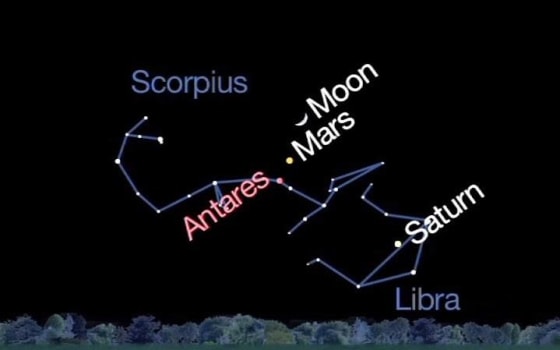Skywatchers have a chance to see the moon sweep past a fading Mars on Monday night.
After the sun goes down this evening, look about 15 degrees up from the southwest horizon. (The width of your clenched fist held at arm’s length measures about 10 degrees.) There you’ll see a crescent moon, 30 percent illuminated. Hovering almost directly below it will be a moderately bright yellow-orange "star."
That’s no star; it's Mars, which shone nearly nine times brighter just five and a half months ago. The Red Planet continues to recede from Earth and consequently is fading in the night sky. [Amazing September Night Sky Photos by Stargazers]
Currently Mars is 142 million miles (228 million kilometers) away and shines at magnitude 0.8. On the list of the 21 brightest stars, Mars would currently rank 13th — quite a comedown from early April, when the planet was more luminous than Sirius, the brightest star in the sky.
In terms of apparent size, the disk of Mars is downright tiny; only a large amateur telescope is likely to show any dusky markings on it.
The gap separating the moon from Mars tonight will be about 6 degrees, which is slightly greater than the distance that separates the Pointer Stars (Dubhe and Merak) at the end of the bowl of the Big Dipper, which point the way to Polaris, the North Star.
Mars is currently positioned against the distinctively bright stars of the constellation Scorpius, the Scorpion. In fact, the Red Planet is hovering only about 3 degrees directly above its so-called "rival," the ruddy star Antares, which marks the heart of the scorpion.
— Joe Rao, Space.com
If you capture an amazing image of the night sky and would like to share it for a possible photo story or gallery, send images and comments in to: spacephotos@space.com.
Joe Rao serves as an instructor and guest lecturer at New York's Hayden Planetarium. He writes about astronomy for Natural History magazine, the Farmer's Almanac and other publications, and he is also an on-camera meteorologist for News 12 Westchester, N.Y. This is a condensed version of a report from Space.com. Read the full report. Follow Space.com on Twitter, Facebook or Google+.
